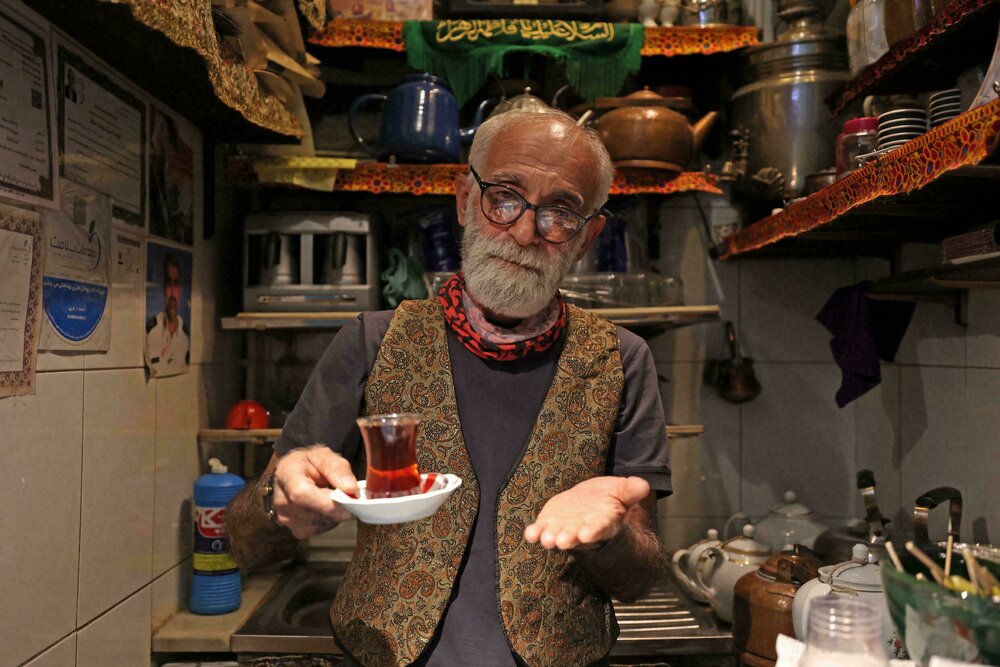Tiny teahouse in Tehran brews up love for customers

TEHRAN - With his trimmed beard, red scarf, and bronze-colored waistcoat, Kazem Mabhutian serves a steady stream of customers in the smallest and oldest teahouse in Tehran, but at 63 years old, he is counting on God to find him a successor.
Tucked in an alleyway of the Grand Bazaar, wedged between a clothes shop and the door of a mosque, his 1.5-square-metre chaikhaneh (tea house) is invisible from the main street. And yet it is the most famous among tea connoisseurs in the Iranian capital.
In between pouring glasses of steaming brew for his customers, Mabhutian tells the century-old story of the fabled Haj Ali Darvish Tea House with pride.
His father Haj Ali Mabhutian, nicknamed the Dervish or Beheshti, or “He who deserves paradise”, was born in Hamedan in western Iran, he says.
“He came to Tehran at the age of 15 to earn a living. He bought this shop from Haj Hassan who had opened it in 1918.”
Arranged around him are cups and teapots, boxes of tea, and a samovar water-heater. There is an antiquated radio, a paraffin lamp, statuettes of dervishes, and gold-colored sticks of Nabat, a saffron-scented barley sugar.
On the wall, a tourism ministry certificate assures that the place “is part of the intangible heritage of the national culture”.
‘Tea of kindness’
Aside from the traditional Iranian black tea, Mabhutian prepares cardamon, cinnamon, mint, thyme and hibiscus brews every day from 7:30 am. But his favorites is his signature “tea of kindness”, a mixture of mint, lemon, and saffron which gives it a zesty yellow color.
Business is usually steady: experts say that Iranians consume an average of nine small glasses of tea a day, or 100,000 tones nationwide every year.
“Until 2007, my father ran this house, known as the smallest in the world,” said Mabhutian. “Then he broke his leg and never returned to work. He stayed at home until his death in 2018 at the age of 92.”
Kazem then left his advertising agency job and took over the business. “I don’t regret it at all,” he said. “Advertising was a business, but this is a question of love. I chose this job with my heart, not for the money.”
On the menu, the price of a cup of tea is listed at 100,000 rials (35 cents), but “the rates are not fixed,” he said. “It depends on the financial situation of the customer.”
Every day he serves some 200 customers. “Most of them come from outside the market because they know us,” he said.
“There used to be a lot of tourists too, because this shop was in the guidebooks, but the foreigners disappeared with the pandemic.”
‘Made with love’
Given the miniature size of the teahouse, there are no tables, but customers can pull up a plastic stool outside, amid the bazaar’s bustle.
Seated there was Shafagh, a 32-year-old graphic designer, with her friend Forough, 47. “Everyone sells tea, but the important thing is to know how to make it,” said Shafagh, enjoying a cup of kindness tea. “It’s like cooking -- when someone makes tea with love, it tastes completely different.”
Forough chimed in that “I also come to chat with the owner. I think his tea is nothing like the tea served in other places”.
Every weekday, Habibollah Sayadi, 70, leaves his nearby clothing shop to enjoy his Iranian black tea. “I’m a regular -- I’ve been coming here for almost 50 years because I love the taste of his tea,” he said, adding approvingly that “Mr. Kazem respects hygiene” in times of Covid.
Mabhutian, the owner, is getting on in years and is still single, so does he worry about what will become of his beloved shop in the future?
“Not at all,” he said confidently. “God will find me a successor. A place like this one does not die.”
A maze of bustling alleys
Situated in the heart of Tehran, the Grand Bazaar resembles a giant maze of bustling alleys, corridors, lanes, intersections, entrances, and passageways with hundreds of shops offering different types of goods and services. It is a place to explore, to discover everyday life of the locals, and to spend time here to get fun.
While most of its covered structures and marketplaces are associated with the 19th century onwards, the history of trade in the bazaar is rooted much deeper in time.
Some visitors to the bazaar refer to it as “a city within a city” because it also includes several mosques, guesthouses, banks, and once-thriving caravansaries.
Most mazes and lanes are particularly allocated to commodities such as carpets, metalwork, spices, toys, clothing, jewelry, woodturning, and kitchen appliances.
One can also encounter with grocery stores, bookbinders, blacksmiths, tinsmiths, coppersmiths, tobacconists, tailors, flag sellers, broadcloth sellers, carpenters, shoemakers, and knife-makers, among others.
AFM
(Source: AFP)
